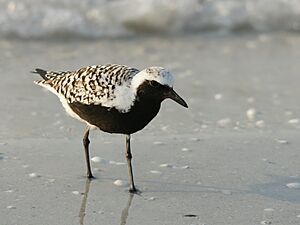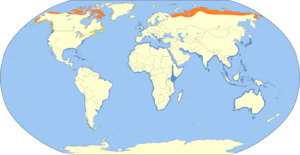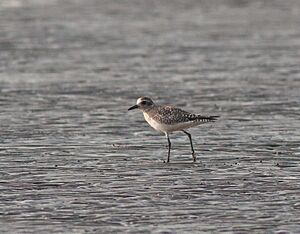Grey plover facts for kids
Quick facts for kids Grey plover |
|
|---|---|
 |
|
| Adult in breeding plumage | |
| Conservation status | |
| Scientific classification | |
| Genus: |
Pluvialis
|
| Species: |
squatarola
|
 |
|
| English: Geographical distribution of Grey Plover. Breeding Migration Nonbreeding | |
| Synonyms | |
|
Tringa squatarola Linnaeus, 1758 |
|
The grey plover or black-bellied plover (Pluvialis squatarola) is a large plover bird. It lives and breeds in the cold Arctic regions. This bird is a long-distance traveler, flying far for its migrations. When it's not breeding, you can find it along coasts almost everywhere in the world.
Contents
What is a Grey Plover?
The grey plover was first officially described in 1758. A Swedish scientist named Carl Linnaeus gave it the name Tringa squatarola. Today, it is grouped with three other plovers in the Pluvialis family. This family name comes from a Latin word meaning "relating to rain." People once thought these birds gathered when rain was coming.
You might hear this bird called different names. In Europe, Asia, and Africa, it's usually called the "grey plover." But in North and South America, it's known as the "black-bellied plover."
There are three main types, or subspecies, of grey plovers:
- P. s. squatarola: These birds breed in northern Europe and Asia, and also in Alaska. They spend their winters in parts of Europe, Africa, Asia, Australia, and the Americas.
- P. s. tomkovichi: This type breeds on Wrangel Island, which is in northeast Siberia.
- P. s. cynosurae: These plovers breed in northern Canada. They spend their winters along the coasts of North and South America.
How to Spot a Grey Plover
Grey plovers are about 27 to 30 centimeters (11 to 12 inches) long. Their wings can spread out to 71 to 83 centimeters (28 to 33 inches). They usually weigh between 190 and 280 grams (6.7 to 9.9 ounces). Before a long flight, they can weigh up to 345 grams (12.2 ounces).
In spring and summer, adult birds have cool black and white spots on their backs and wings. Their face and neck are black with a white border. They have a black chest and belly, and a white rump (the back part above the tail). Their tail is white with black stripes. Both their beak and legs are black.
Around August or September, they change their feathers for winter. They become a plain grey on top, with a grey-speckled chest and a white belly. Young birds look similar to the winter adults. However, their back feathers are darker with creamy white edges.
When a grey plover flies, you can easily tell it apart from other plovers. It has black feathers under its wings, near its body. On the ground, you can also spot it by its larger, heavier beak, which is about 24 to 34 millimeters (0.9 to 1.3 inches) long.
Grey Plover Homes and Journeys
Grey plovers make their homes in the Arctic islands and coastal areas. This includes the northern coasts of Alaska, Canada, and Russia. They build their nests on the ground in dry, open tundra areas. These spots offer good views around them. The nest is a shallow scrape in the gravel.
They usually lay four eggs, sometimes three, in early June. The eggs hatch after about 26 to 27 days. The young chicks are ready to fly when they are 35 to 45 days old. Young birds do not breed until they are two years old. They usually stay in their winter homes until their second summer.
These birds travel far for winter. In the Americas, they fly south from places like British Columbia and Massachusetts. They can go all the way to Argentina and Chile. In Europe, Africa, and Asia, they travel from places like Ireland and Norway. They go south through coastal Africa to South Africa, and through southern Asia to Australia. A few even reach New Zealand. Most of the birds that fly to Australia are females.
Grey plovers often fly long distances without stopping. They cross continents like Asia, Europe, and North America. They usually stay near coasts. It's rare to see them far inland, unless bad weather forces them down. They might land on the shores of very large lakes, like the Great Lakes, where they are common visitors during migration.
What Grey Plovers Eat
Grey plovers look for food on beaches and tidal flats. They usually spot their food with their eyes. Their diet includes small shellfish, worms, crustaceans (like crabs), and insects.
These birds are not as social as other plover types. They don't form big groups when they eat. Instead, they spread out widely across beaches, with each bird keeping its distance. However, they will gather in large groups when they rest during high tide.
Is the Grey Plover Safe?
The International Union for Conservation of Nature (IUCN) has looked at the grey plover's population. They have decided that the bird is of "Least concern." This means it is not currently at risk of disappearing. The grey plover is also part of an agreement called the Agreement on the Conservation of African-Eurasian Migratory Waterbirds (AEWA). This agreement helps protect birds that migrate across Africa and Eurasia.
Gallery







